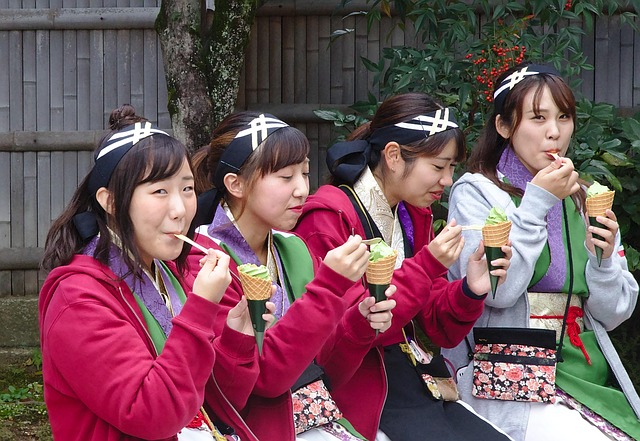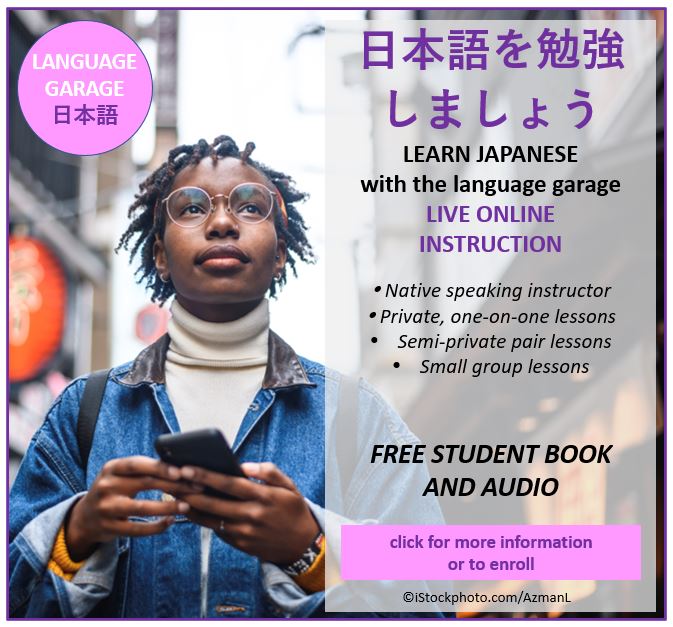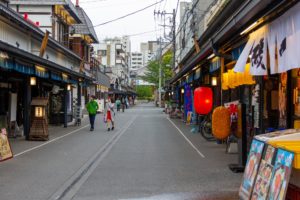Japanese Non-Past Tense: Plain and Polite Forms Explained
In this post we’re going to learn about the Japanese non-past tense. We’re going to cover the two forms that are most important to learners of Japanese, the plain and polite forms. First, we’ll explain what the Japanese non-past tense is and what it corresponds to in English. Next, we’ll look at the difference between the plain and polite forms and when you should use each one. Then we’ll look at different Japanese verb groups, and we’ll learn how to make polite forms out of each one.
What Is the Japanese Non-Past Tense?
Japanese does not have separate verb forms for present and future. Instead, it uses the non-past tense (現在形 / genzaikei) to express both:
- お茶を飲みます。
Ocha o nomimasu.
I drink tea. / I will drink tea. - 日本語を勉強します。
Nihongo o benkyō shimasu.
I study Japanese. / I will study Japanese.
Remember though that this tense does not refer to something happening right now, but rather to general or habitual actions. If you want an equivalent of English am/is/are -ing, use the –ています -te imasu form.
- 茶を飲んでいます。
Ocha o nonde imasu.
I am drinking tea (now). - 日本語を勉強しています。
Nihongo o benkyō shite imasu.
I am studying Japanese (now).
Plain and Polite Forms in the Japanese Non-Past Tense
Japanese has different speech levels that you use depending on who you’re speaking to. The non-past tense has two primary forms that every student should know, the plain form (also called the dictionary form), and the polite form.
| Form | Use | Example |
| Plain (dictionary) | Friends, family, inner thoughts, casual writing | 食べる taberu (eat) 飲む nomu (drink) 話す hanasu (speak) |
| Polite | Strangers, teachers, service workers, formal settings | 食べます tabemasu (eat) 飲みますnomimasu (drink) 話します hanashimasu (speak) |
Notice that the plain form is simply the form that you’ll find in a dictionary or a translation app if you look up to eat or to drink, for example. The polite form is a conjugated form of that, and it typically ends in –ます -masu. How you get a polite form from a plain or dictionary form depends on which group the verb belongs to. We’ll come back to that in just a moment.
Honorific and Humble Forms
There are two other forms (or speech registers) in the Japanese non-past tense. They are the 尊敬語 sonkei-go (honorific) and 謙譲語 kensetsu (humble). We won’t get into them now, but you should at least be aware of their existence. They’re mostly used in business, formal speech, or polite writing. The honorific is used when you want to elevate the status of someone you’re speaking about. You’d use it to talk about the actions of your boss, a customer, a teacher, or a valued guest, whether you’re talking to that person or about them. When you’re talking about yourself to one of these people, you use the humble form for your own actions. This lowers your own status in relation to them.
- 社長は今、会社にいらっしゃいます。
Shachou wa ima, kaisha ni irasshaimasu.
The president is at the office now.
Honorific: You’re talking about a higher-ranking individual at your company. - 先生にお渡しします。
Sensei ni owatashi shimasu.
I will give it to the teacher. / I will give it to you, teacher.
Humble: You’re talking about yourself either to or in reference to a higher-ranking individual.
How to Conjugate Verbs in the Japanese Non-Past Tense
Remember that the polite form is derived from the plain or dictionary form. For the polite form, just add –ます -masu to the verb root. But how you get to the root from the plain form depends on which group the verb belongs to: Group 1, Group 2, or Irregular.
Group 1: う -u Verbs (Godan Verbs)
The first group of verbs is called 五段動詞 godandōshi (godan verbs). They all end in the vowel –u in romaji, but in kana that –u is always attached to a consonant, so there isn’t one simple “letter” repeated across all endings. The endings could be any of the characters in the う –u line of the hiragana chart: –く –ku, –す –su, –む –mu and so on.
- 書く kaku to write
- 話す hanasu to speak
- 飲む nomu to drink
- 入るhairu to enter
- 買う kau to buy
It’s much easier to conjugate う -u verbs if you think of them in romaji. Just change the –u to –i to get the root, and then add –ます –masu: kaku > kaki > kakimasu. But if you think of them in kana, you have to change the character from the う –u line to the corresponding character in the い -i line to get the root. So く ku becomes き ki, す su becomes し shi, and so on. Then you add –ます –masu.
| plain form | root | polite form | English |
| 書く kaku | 書き– kaki- | 書きます kakimasu | write, writes, will write |
| 話す hanasu | 話し– hanashi- | 話します hanashimasu | speak, speaks, will speak |
| 飲む nomu | 飲み– nomi- | 飲みます nomimasu | drink, drinks, will drink |
| 入るhairu | 入り– hairi- | 入ります hairimasu | enter, enters, will enter |
| 買う kau | 買い– kai- | 買います kaimasu | buy, buys, will buy |
Examples of う -u Verbs
- 毎日コーヒーを飲む。
Mainichi koohii o nomu.
I drink coffee every day. - 毎日コーヒーを飲みます。
Mainichi koohii o nomimasu.
I drink coffee every day. - 明日学校へ行く。
Ashita gakkou e iku.
I will go to school tomorrow. - 明日学校へ行きます。
Ashita gakkou e ikimasu.
I will go to school tomorrow. - 毎週日曜日に公園で歩きます。
Maishū nichiyōbi ni kōen de arukimasu.
We walk in the park every Sunday. - 毎週日曜日に公園で歩く。
Maishū nichiyōbi ni kōen de aruku.
We walk in the park every Sunday. - 手を洗います。
Te o araimasu.
I wash my hands. - 手を洗う。
Te o arau.
I wash my hands.
Group 2: る -ru Verbs (Ichidan Verbs)
Verbs in the second group are very easy to conjugate. You may also hear them called 一段動詞ichidan dōshi (ichidan verbs). These verbs all end in る -ru, for example:
- 食べる taberu to eat
- 見る miru to see
- 寝る neru to sleep
- 始める hajimeru to begin/start (something)
- 答える kotaeru to answer
To conjugate a る -ru verb, simply remove the final る -ru, and you’ll be left with the root, ending in a vowel, usually –e or -i. Then simply add –ます –masu.
| plain form | root | polite form | English |
| 食べる taberu | 食べ tabe- | 食べます tabemasu | eat, eats, will eat |
| 見る miru | 見 mi- | 見ます mimasu | see, sees, will see |
| 寝る neru | 寝 ne- | 寝ます nemasu | sleep, sleeps, will sleep |
| 始める hajimeru | 始め hajime- | 始めます hajimemasu | start, starts, will start |
| 答える kotaeru | 答え– kotae- | 答えます kotaemasu | answer, answers, will answer |
Examples of る -ru Verbs
- 友達と出掛けます。
Tomodachi to dekakemasu.
I go out with my friends. - 友達と出かける。
Tomodachi to dekakeru.
I go out with my friends. - たいてい何時に寝ますか。
Taitē nanji ni nemasu ka.
What time do you usually go to bed? - たいてい何時に寝る?
Taitē nanji ni neru?
What time do you usually go to bed? - ドアを開けます。
Doa o akemasu.
She opens the door. - ドアを開ける。
Doa o akeru.
She opens the door. - ご飯をたくさん食べます。
Gohan o takusan tabemasu.
I eat a lot of rice. - ご飯をたくさん食べる。
Gohan o takusan taberu.
I eat a lot of rice.
る -ru Godan Verbs
Not all verbs ending in る -ru belong to Group 2 ichidan verbs. For example, you saw that 入るhairu (to enter) is a Group 1 godan verb. Often it’s easy to know whether a verb ending in る -ru is actually a godan verb. If the vowel before る -ru is a, o, or u, it’s definitely a godan verb. For example, these are all godan verbs:
- 分かる wakaru to understand
分かります wakarimasu understand, understands, will understand - 寄る yoru to stop by, to drop in
寄ります yorimasu stop by, stops by, will stop by - 眠る nemuru to fall asleep
眠ります nemurimasu fall asleep, falls asleep, will fall asleep
If the vowel before る -ru is e or i, it’s probably an ichidan verb. But there are exceptions, as we saw with 入るhairu.
Irregular Verbs
Japanese only has two irregular verbs.
| plain form | polite form | English |
| する suru | しますshimasu | do, does, will do |
| 来る kuru | 来ますkimasu | come, comes, will come |
Examples of Irregular Verbs
Now let’s see some example sentences of irregular verbs in both the plain and polite forms.
- 日本語を勉強する。
Nihongo o benkyou suru.
I study Japanese. - 日本語を勉強します。
Nihongo o benkyou shimasu.
I study Japanese. - 今週末のパーティーには誰が来ますか。
Konshūmatsu no pātī ni wa dare ga kimasu ka.
Who’s coming to the party this weekend? - 今週末のパーティーには誰が来る?
Konshūmatsu no pātī ni wa dare ga kuru?
Who’s coming to the party this weekend?
Practice
Change each of the following plain form sentences into polite forms. The verb group is given to help you. Translate the sentences. Use I for statements, and you for questions.
- 車で仕事に行く。 (group 1)
Kuruma de shigoto ni iku. - 電車は午前10時に到着する。(irregular)
Densha wa gozen jūji ni tōchakusuru. - いつも朝シャワーを浴びる。(group 2)
Itsumo asa shawā o abimasu. - お風呂には入る。(group 1)
Ofuro ni wa hairu. - 素早く服を着る。(group 2)
Subayaku fuku o kiru. - たいてい何時間寝る? (group 2)Remember to add か ka in polite questions!
Taitē nanjikan neru? - 毎日友達と話す。 (group 1)
Mainichi tomodachi to hanasu. - 朝は電車とバスのどちらを使う? (group 1)Remember to add か ka in polite questions!
Asa wa densha to basu no dochira o tsukau? - 毎日音楽を聴く。 (group 1)
Mainichi ongaku o kiku. - この店でいつも面白いものを見つける 。(group 2)
Kono mise de itsumo omoshiroi mono o mitsukeru.
Get on the road to speaking Japanese with the Language Garage!
We hope you’ve enjoyed learning about the Japanese non-past tense. If you’d like to learn more:
- Follow us on Facebook, LinkedIn, BlueSky, Twitter, Threads, Mastodon, Instagram, or Pinterest. We publish lots of Japanese vocabulary, grammar, and culture notes, so it’s a great way to pick up some new vocabulary and practice.
- Check out our other posts on Japanese language, culture, and more.
- Enroll in affordable, flexible, and personalized private online Japanese lessons or sign up for a small group online Japanese class.
- Create a free Language Garage account to access tons of Japanese vocabulary, grammar, and culture.
Answer Key
- 車で仕事に行きます。
Kuruma de shigoto ni ikimasu.
I go to work by car. - 電車は午前10時に到着します。
Densha wa gozen jūji ni tōchakushimasu.
The train arrives at 10am. - いつも朝シャワーを浴びます。
Itsumo asa shawā o abimasu.
I always take a shower in the morning. - お風呂には入りません。
Ofuro ni wa hairimasen.
I never take a bath. - 素早く服を着ます。
Subayaku fuku o kimasu.
I get dressed quickly. - たいてい何時間寝ますか。
Taitē nanjikan nemasu ka.
How many hours do you usually sleep? - 毎日友達と話します。
Mainichi tomodachi to hanashimasu.
I talk with my friends every day. - 朝は電車とバスのどちらを使いますか。
Asa wa densha to basu no dochira o tsukaimasu ka.
Do you take the train or the bus in the morning? - 毎日音楽を聴きます。
Mainichi ongaku o kikimasu.
I listen to music every day. - この店でいつも面白いものを見つけます。
Kono mise de itsumo omoshiroi mono o mitsukemasu.
I always find something interesting in this store.






